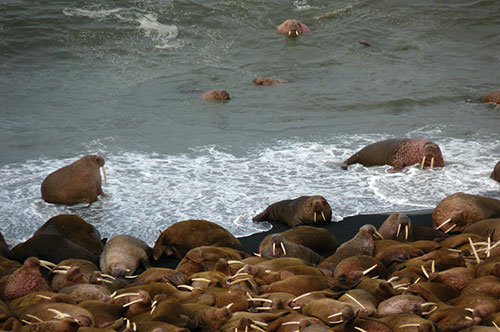
Alaskans Team Up to Prevent Walrus StampedesBy ANDREA MEDEIROS
March 05, 2015
With the loss of summer sea ice, walruses that would normally rest on floating patches of ice in small groups are hauling out on land in large congregations. When these large groups are startled, they rush back into the water in what is called a stampede. In the process, small young walruses can be crushed.
When large groups of Pacific walruses, such as these near Alaska Peninsula National Wildlife Refuge, are startled, they rush back into the water in a stampede. In the process, small young walruses can be crushed. Climate change may be exacerbating the problem. The refuge is helping the Alaska SeaLife Center monitor walrus behavior.
In Point Lay, residents long have taken pride as stewards of the Pacific walrus, partnering with the Service to ensure that locals and visitors avoid disturbing the marine mammal. The Service has developed flight guidelines for local air carriers and pilots and issues advisories when a haulout forms. The Service also works with the FAA to establish temporary flight restrictions; and the Point Lay community works directly with air carriers to establish new flight paths. These efforts have kept walrus deaths remarkably low. Some 800 miles south of Point Lay, Alaska Peninsula Refuge is working with the Alaska SeaLife Center, whose scientists and veterinarians began a study in 2011 about walrus responses to disturbance. They placed weather-proof cameras at several walrus haulout spots to record images of the haulouts from May through September. One monitoring site is on Cape Seniavin near the refuge. It is a favored resting area for male walruses feeding in nearby shallow waters. “You smell the walruses long before you see them,” says refuge pilot/biologist Dan Pepin. “As I laid on my stomach and peered over the bank to the northwest, I saw the walruses both on the beach and negotiating the surf. It was truly an amazing experience.” Cape Seniavin is a popular destination for wildlife viewers and ivory collectors, setting the stage for stampede events. Even though the haulout site is not on the refuge, the refuge plays a key role in keeping the monitoring cameras operational. Every 60 days, a refuge pilot visits the site to maintain camera platforms and replace batteries and SD memory cards. “I am happy that we are in a position to help with the walrus cameras,” says refuge manager Susan Alexander. “Our logistical capability operating on the peninsula allows us to contribute to the conservation of this fantastic local resource.” The refuge helps the SeaLife Center stretch funds and increase monitoring efforts, and Service law enforcement officers and scientists at the center educate visitors about why walruses should not be disturbed, how to avoid doing so, and the consequences of failing to abide by the Marine Mammal Protection Act. From understanding walrus response to changing climate conditions to minimizing the untimely deaths of young animals, partners on and off refuges are helping to increase the odds that these amazing creatures will be around to thrill future generations.
Related:
Andrea Medeiros is a public affairs specialist in the USFW Alaska Region office in Anchorage.
Source of News:
|
||
